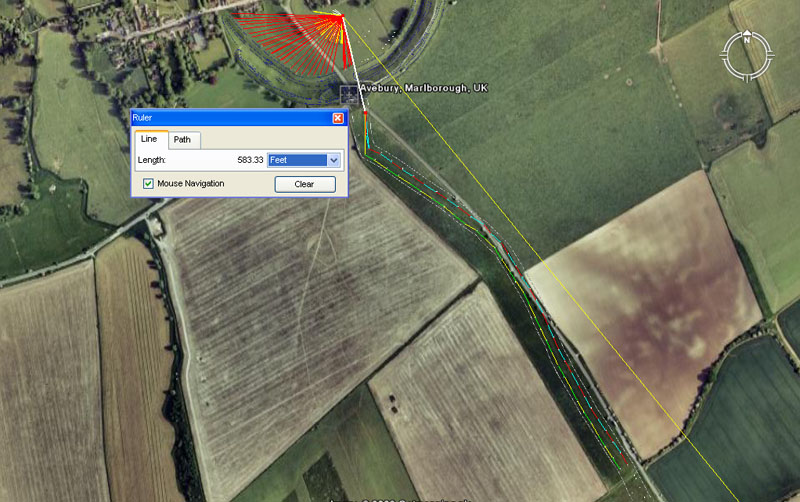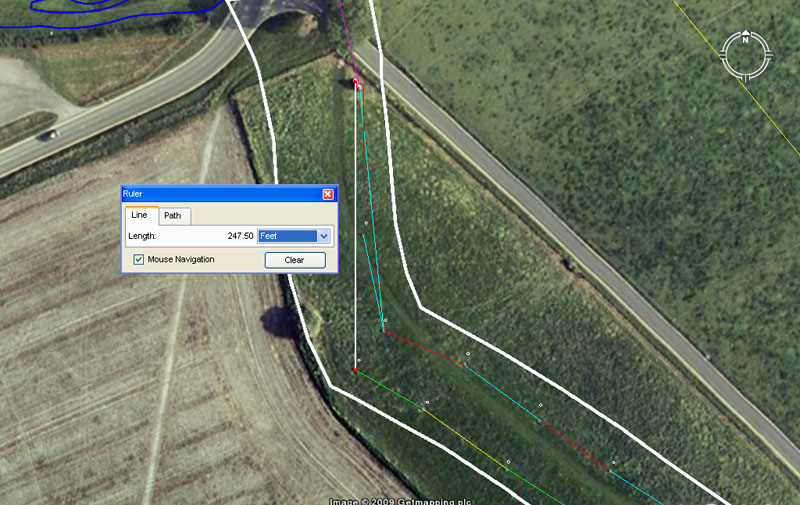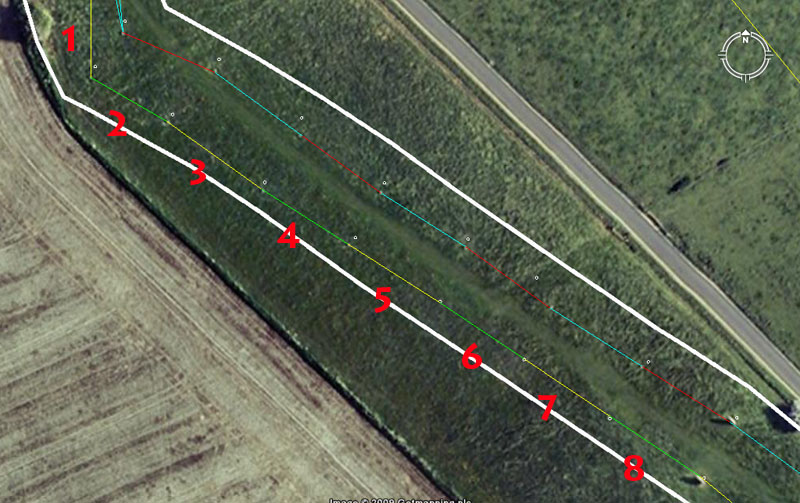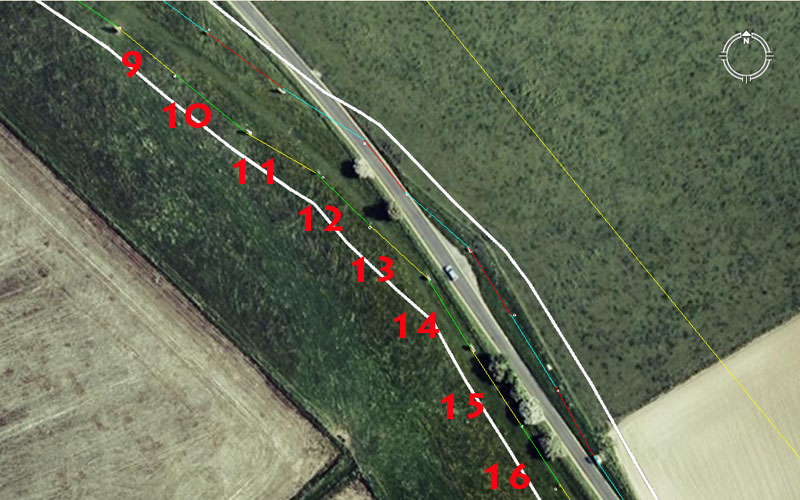SAILING DOWN THE WEST KENNET AVENUE.
At the southern gate of Avebury Henge there is a huge obelisk
standing off to the side. This marks the beginning of the West Kennet Avenue,
which runs to the Sanctuary Circle 1.4-miles to the southeast. The Avenue
is marked by 2 rows of stones and there were, originally, about 100 of them.
Unfortunately, in an effort to exorcise the devil from Avebury, zealous Christians
of the 14th century AD and thereafter destroyed many of these markers. Thankfully,
English Heritage archaeologists and other dedicated antiquarians have erected
plinths to mark the precise spots where many of the plundered stones once
stood, so sufficient evidence still exists to painstakingly determine mathematically
what the purpose of the stone rows was.

A white line runs for 583.33333-feet from the obelisk
within Avebury Henge to the centre of the eastern face of a large obelisk
standing outside the southern gate at the beginning of West Kennet Avenue.
The azimuth angle to this position is 166.6666-degrees (166 & 2/3rds).
This gets students of navigation from the henge's main obelisk position to
the giant obelisk where the comprehensive navigational tutorials begin. The
values of distance and angle to this point are highly significant to ancient
positional plotting methodology and this will become very apparent as we proceed.
The distance coding from the obelisk means five things
simultaneously, depending upon what calculating function one is undertaking
from this beginning position.
From this beginning position at the southern gate of Avebury, students of navigation
learned how to do accurate positional plotting at sea, using two separate systems.
These were:
- The so-called Greek "6&7" system that used a mile of 5250-feet.
This is the literal system encoded into the base dimensions of the Great Pyramid
@756-feet per side. Two circumnavigations of the Great Pyramid measured 6048-feet
for 1-minute of equatorial arc.
- The so-called British "11" system that used a mile of 5280-feet.
If the Great Pyramid was elongated (symbolically) by a mere 3-inches to 756.25-feet,
then it would encode this system. Two circumnavigations of the Great Pyramid
measured 6050-feet for 1-minute of equatorial arc.
In the above picture less than half of the West Kennet
Avenue is seen. Meandering lines in different colours are shown to be running,
side by side and from stone to stone down each side of the Avenue.
The yellow & green lines mark a route that was set out in
increments that related to the "11" series mile of 5280-feet.
The cyan & red lines mark a route that was set out in increments
that related to the "6&7" series mile of 5250-feet.
The students would navigate from stone to stone down the particular
lines under study, stopping at each station to calculate the distance covered
and the degree angles back to the point of departure and onwards to the destination.
The distances between standing stones represented sea-legs of travel using
specific increments of distance and angle relative to the system under study.
At the end of a "sea-leg", the linear distance covered had to be
converted to a scaled circumference (drawn, undoubtedly, on a large slate
with a sharpened chalk pencil, aided by a compass drawing tool), then the
precise degree angles worked-out with the aid of scaled rules and abacus calculators.
LET'S GO SAILING

From the designated launching position on the giant
stone at the southern gateway, the students and their master traveled 247.5-feet
due south to a small stone marker. The distance is symbolically representative
of the 24750-mile (of 5280-feet) circumference of the Earth and all increments
of lengths and angles encountered on this voyage to the Sanctuary Circle will
relate to the "11" system of measurement (league @ 16500-feet, mile
@ 5280-feet, furlong or furrowlong @ 660-feet, chain @ 66-feet, rod or perch
@ 16.5-feet, fathom @ 5.5-feet, link @ 7.92-inches).
Leg 1
The distance covered (247.5-feet) is converted to a circle using
PI @ 3.141818182 (essentially 314 & 2/11ths ÷
100). This renders the "11" series diameter into a circumference
that is perfectly divisible within a 360-degree environment. Therefore: 247.5-feet
X 3.141818182 = 777.6-feet. Under this reading each 2.16-feet (2 &4/25ths
...25.92-inches) of circumference represented 1-degree of arc. Using a scaled
rule and calipers the students could draw a scaled circle onto their (slate
?) chart and plot their first position away from the point of departure. Having
established the position of true North, they could now use their scaled circle
to accurately mark any point of the compass by calculation., They could work
out the degree angle back to the obelisk position within the henge or, say,
to the crown of Silbury Hill, etc. Their final destination was to be the Sanctuary
Circle, 7920-feet from the obelisk at Avebury Henge, sitting at an azimuth
angle of 140.8 -degrees from the henge obelisk.
The 7920-feet of distance from the obelisk within the henge
to the Sanctuary, if read as miles, would represent the true diameter of the
Earth. The angle of 140.8-degrees from the obelisk to the Sanctuary Circle
is coding under the mile of 5280-feet and 14080-feet would be 2 & 2/3rds
miles. A mathematical progression based upon 704 (1/2 of 1408) is very important
to the 5280-feet mile and 70.4-feet is 1/75th of a mile.
With regards to the first plotting circle mentioned, with a
circumference of 777.6-feet, if this was read as miles then it would be 1/32nd
of the 24883.2-mile circumference of the Earth. In this same plotting circle,
the increment representing 1-degree of arc is 2.16-feet. The Sun spends 2160-years
in each house of the zodiac during the 25920-year cycle of precession, etc.
It is very important at this point to realise what's going on
mathematically and to realise that the two systems of navigation were interrelated
by two very close renditions of PI.
When using the "11" system, as we are doing now, the
rendition of PI is 3.141818182. This converts an "11" diameter to
(what is exploitable as) a sexagesimal circumference. In other words, the
diameter immediately becomes the "6&7" system on the circumference
divisible by 360-degrees.
Alternatively, when using the "6&7" system for
linear travel as a straight-leg diameter, the rendition of PI used is 22/7ths.
This converts the circumference to an "11" series reading. For example:
One Greek mile of travel (5250-feet) X 22/7ths (3.1428571) = 16500-feet (an
ancient British league of 3.125-miles) or 550-inches per degree of arc.
These two navigational systems seem to have been built into
the base diameter of Silbury Hill. In one cross measure through the hill the
distance is 525-feet, which indicates a circumference of 1650-feet (divisible
by "11" within a 360-degree environment) using PI @ 22/7ths. In
the other cross measure the diameter is 550-feet, which gives a circumference
of 1728-feet (divisible by "6&7" within a 360-degree environment)
using PI @ 3.141818182.
Leg 2.
The students now "sail" away on the second leg of
their journey, but this time it's on a heading of 120-degrees and a distance
of 66-feet (1 chain) is covered. This segment of the voyage is now converted
to a plotting circle on the slate. Therefore: 66 X 3.141818182 = 207.36-feet
or 2488.32-inches. This means that 1-degree of arc is 6.912-inches or .576
(72/125ths) of a foot.
Remember: The Earth was considered to be 12 X 12 X 12 X 12 X
1.2-miles in circumference (24883.2-miles) under the literal system built
into the Great Pyramid. In that calibration the miles were 5250-feet each.
Yet another system used the same value, but in conjunction with a mile of
5280-feet. That "true" size value is only 18.8-miles short of the
figure we use today.
The longest of the Egyptian Royal Cubits was 1.728-feet or 20.736-inches.
This Egyptian Royal Cubit's length X 1200 = 24883.2. A cubic foot (12 X 12
X 12 -inches) = 1728 cubic inches, etc.
Leg 3.
The student navigators, with their master at the helm set out
on the next leg. This time the trainee-navigators veer 6-degrees further towards
the South on a heading of 125.55555-degrees (the opposite of 305.5555 or 1/18th
of 5500) and cover 88-feet during the leg. Again, the distance is converted
to a plotting circle, therefore: 88-feet X 3.141818182 = 276.48-feet. This
means that each degree of arc = 9.216-inches or .768 (96/125ths) of a foot.
The sum of 921.6-miles would be 1/27th of the 24883.2-mile circumference.
Leg 4.
Again the intrepid voyagers set out, but change their heading
to 122.5-degrees (the opposite of 302.5-degrees). Under the "11"
system perimeter value of the Great Pyramid @ 756.25-feet per side, one circumnavigation
was 3025-feet. This leg of the journey covers 77-feet, which is later converted
to a plotting circle. Therefore: 77 X 3.141818182 = 241.92-feet or 8.064-inches
or .672 (84/125ths) of a foot per degree of arc.

The above picture shows an overlay of surveying information
provided by English Heritage & AutoCAD lines superimposed upon the Google
Earth image of West Kennet Avenue. Small white dots, which came with the English
Heritage digital file, indicate the approximate positions of the marker stones
on the Avenue. It seems probable that these slightly askew marks were done
some years ago with a handheld GPS unit, which would account for the few feet
of error in some instances. The white dots are, however, very helpful in locating
the true positions of the markers in Google Earth. The bold white lines are
from the English Heritage digital file and seem to very accurately mark the
sides of the original Avenue of 5000-years ago. This overlaid Avenue drawing
ends perfectly at the edge of the Sanctuary Circle. The thin, yellow AutoCAD
line at the right side of the picture runs for 7920-feet from the obelisk
in Avebury Henge to the Inner circle of the Sanctuary.
In the preceding commentary the mathematical method has been
described to convert each leg of the journey into an calibrated circle from
which accurate degree angles back to the point of departure and onwards to
the destination or to any landmark could be calculated. Under this system
the "foot" value of the outer circumference was divided up into
125 parts per foot. This meant that navigators using the "11" system
of increments could, potentially, work to a refined tolerance of 45000 calibrations
per 360-degrees if they so desired or had the visual capacity to do so.
The point is that the mathematical accuracy and capacity to
work to finite refinements was achievable under their very sophisticated system.
When the skeleton of an ancient dignitary of obvious importance was found
buried at Bush Barrow tumulus mound beside Stonehenge, a plane table and alidade
sighting rule were found to be buried with him. This find should give us some
clues as to how the angle calculations were being expedited, as well as refinements
or tolerances achieved.
The ancient navigator-mathematicians of 5000-years ago not only
had a very accurate concept of the true size of the Earth, but they also had
a very versatile, factorable and precise method for doing positional plotting.
The mathematical sophistication is more than sufficient to do very good relative
computations of Longitude, as
well as Latitude. An experienced
navigator, keeping a very good record of boat speed, distance covered and
heading angle in each leg, had at his disposal, an accumulation of known-length
and angles to calculate from. As the voyage proceeded, angles of heading could
be added to or subtracted from with each new leg. Accuracy in determining
angles could be easily calculated by converting the leg length of travel into
a calibrated circle of very precise incremental values. Any of the points
of the compass could be easily determined using this mathematical method.
As long as the experienced navigator was adept at calculating distances covered,
then calculating longitude was achievable.
Other navigational aids would have included:
Leg 5.
The length of this leg is 82.5-feet and the
azimuth angle remains 123.75-degrees (half of 247.5-degrees).
This length is 5 rods or 15 ancient fathoms of 5.5-feet each.
When converted to a circle, this length achieves a circumference of 259.2-feet
or .72 of a foot per degree of arc or 18/25ths of a foot.
Leg 6.
The length is 77-feet and the azimuth angle is 123.75-degrees
(half of 247.5).
Again, .672 (84/125ths) of a foot = 1-degree of arc.
Leg 7.
This is an exact repeat of the last leg in distance and angle.
Leg 8.
The length is 82.5-feet and the azimuth angle remains 123.75-degrees.

The voyage continues down the avenue to the Sanctuary
Circle. The precisely drawn and angled lines shown fall accurately onto the
stone positions at each leg of the journey and there can be no doubt that
what is being described mathematically herein was the design intention of
the original architects 5000-years ago.
Leg 9.
Having now sailed for a considerable distance on a lay-line
of 123.75-degrees, the intrepid sailors need to adjust their course. They
veer slightly more to the south and hold a new course of 129.375-degrees (180-degrees
opposed to 309.375-degrees). The sum of 309.375-miles would be 1/80th of the
24750-mile equatorial circumference of the Earth under this "11"
series navigational system.
The distance covered during this leg is 73.33333-feet (73 &
1/3rd). At the end of the run the plotting circle is again created to calculate
the angles back to the port of departure and onwards to the destination. Therefore:
73.3333333-feet X 3.141818182 = 230.4-feet or .64 (80/125ths) of a foot per
degree of arc. The sum of 73.333333-feet would be 1/72nd of a mile.
Leg 10.
The course shifts back eastwards to 129.375-degrees (180-degrees
opposed to 309.375-degrees). The sum of 309.375-miles (309 & 3/8ths) would
be 1/80th of the equatorial circumference of the Earth under the 24750-mile
assignment.
The distance traveled in this leg is 88-feet. This is converted
to a circle and produces 276.48-feet (276 & 12/25ths) of circumference
or .768 (96/125ths) of a foot per degree of arc.
Leg 11.
The distance is 77-feet and the angle is 120-degrees (180-degrees
opposed to 300-degrees).
Again, .672 (84/125ths) of a foot = 1-degree of arc.
The angle was possibly meant to convey 121-degrees in a second
reading (11 X 11).
Leg 12.
The distance is 70.4-feet and the opposed and angle back towards
the henge is 314.1818182-degrees.
This distance, when converted to a plotting circle equals 768/1250ths
of a foot per degree of arc.The sum of 70.4-feet equals 1/75th of a mile.
It would appear that the tutors used this position to teach
the varied expressions of PI, including the more rounded renditions of 3.15
& 3.125.
Leg 13.
The distance is 77-feet and the return angle of travel is 312.5-degrees.
There were 3.125-miles in the ancient British league of 16500-feet.
Leg 14.
The distance is 79.2-feet and the angle is 148.5-degrees.
The smallest increment in the "11" series of lengths
was the link @ 7.92-inches, so this leg-length would be 120 links. The diameter
of the Earth is 7920-miles. The length of this leg of travel X 3.141818182
= 248.832-feet or 864/1250ths of a foot per degree of arc for a circumference
based upon this diameter. Under the other navigational system seen to be running
side-by side to this one being discussed, the equatorial circumference was
24883.2-Greek miles. That navigational method, as taught on the West Kennet
Avenue, will be discussed in depth as we proceed.
The value of 148.5 = 6 X 24.75. It will be remembered that the
equatorial circumference of the Earth coded by this line of increments on
the West Kennet Avenue is 24750-miles of 5280-feet each. The "Y"-Holes
Circle at Stonehenge, measuring 178.2-feet diameter = 2.475-feet X 72. Similarly,
the "Z"-Holes Circle at Stonehenge, measuring 132-feet
(1584-inches) diameter = 24.75-inches X 64.
An increment of length that was coded into landscapes from Britain
to Nazca Peru is based upon the value 891 (2.475 X 360) and it's very apparent
that an increment based upon 2475 was much used in navigational calculations
5000-years ago. The angle value of 148.5 X 3.141818182 = 466.56. At Stonehenge,
a marker in the Avenue indicates the rim of a circle that was intended to
convey 466.56-feet of design diameter.
A circle with a circumference of 466.56-feet would be 1.296-feet
(15.552-inches) per degree of arc. There would be 53 & 1/3rd increments
of 466.56-miles in the 24883.2-mile circumference. Alternatively, there would
be 192 increments of 129.6-miles in the 24883.2-mile circumference. The sum
of 1555.2-miles would represent 1/16th of the 24883.2-mile circumference.
The sum of 1296-years would be half the duration of the Precession of the
Equinoxes (25920-years).
Leg 15.
The distance is 88-feet and the angle is 146.66666-degrees towards
the Sanctuary.
The distance, of course, converts to a circumference of 88-feet
X 3.141818182 = 276.48-feet. This means that each degree of arc = 9.216-inches
or .768 (96/125ths) of a foot. The sum of 921.6-miles would be 1/27th of the
24883.2-mile circumference.
The angle of 146.6666666 (146 & 2/3rds) X 3.141818182 =
460.8 or (÷ 360) 1.28 per degree of arc.
Leg.16.
The distance is 68.75-feet and the angle remains 146.666666-degrees.
Under the 24750-mile assignment for the equatorial circumference,
the sum of 68.75-miles would be 1-degree of arc. This length at West Kennet
Avenue converts to a circle of 216-feet using PI @ 3.141818182 or .6 of a
foot per degree of arc. There would be 115.2 increments of 216-miles in the
24883.2-mile equatorial circumference.
The sun spends 2160-years
in each house of the zodiac during the 25920-year cycle of Precession. The
ancient British Bushel volume was 2160 cubic
inches. Here is one example of the recurring
216 value in ancient mathematical progressions, this time in a Babylonian
volume standard.
BABYLONIAN CAPACITY.
1 Archane…… 129600 cubic
inches, equals:
6 Homer…… @ 21600 cubic inches, or
36 Artaba….. @ 3600 cubic inches, or
216 Sutu…… @ 600 cubic inches, or
2160 Qa……. @ 60 cubic inches.
Having ventured 16 legs down the West Kennet Avenue, we'll take
a little breather, then recommence. The Avenue markers are very complete for
32 legs for the "11" series and somewhat more for the "6&7"
series. In time we should be able to calculate the exact positions where the
missing markers once sat, sufficient for English Heritage archaeologists and
other researchers to relocate the former positions with ground-penetrating
radar.
Continue



